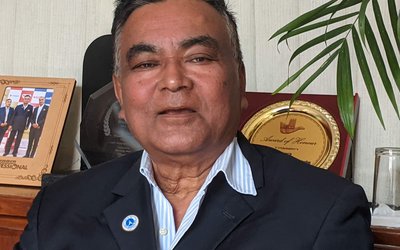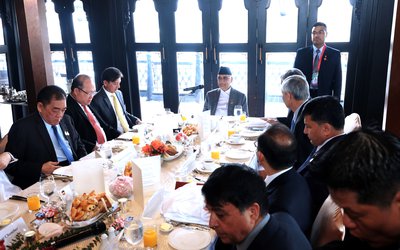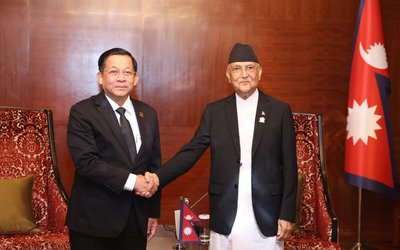
At a time when Nepal’s private sector hydropower developers are suffering from the adverse impacts of the earthquake, KHADGA BAHADUR BISHT, President of Independent Power Producers Association Nepal (IPAN), spoke to NEW SPOTLIGHT on various issues. Excerpts:
How many power projects were damaged by the earthquake?
In the first week, since April 25, initially, we thought the damage might have been minimum. However, after that, we found the damage was much higher in proportion. There was further damage by the aftershock of May 12. Specially large projects suffered much.
Bhotekosi is the largest project badly damaged. Others faced a similar situation. After May 12, at least 80-85 MW power was disconnected from the grid. Some projects resumed power following temporary repair and maintenance. However, they are yet to completely address the damage. So far as Bhotekosi is concerned, it was badly damaged and nobody knows how long it will take to repair it. We have yet to complete rehab. Eighteen projects were badly damaged by earthquake. Out of 18, four projects were rehabilitated within a week. Fourteen projects are still disconnected. There is a disconnection of 70 MW including 45 MW of Bhotekosi.
What is the total monetary damage?
The monetary damage includes rehabilitation costs and revenue losses. I am talking about operating plants. However, it is difficult to calculate loss of other projects which are under construction. The rehabilitation cost of the IPP projects was 2.6 billion rupees. If you include revenues, it will go terribly high. If you add Bhotekosi, it will go much higher.
How are the criteria for membership?
We have two types of membership -- corporate and associate. We have 89 corporate members who operate the plants. This is increasing. IPP’s contribution is 260 and 340 MW is under construction. If you add all under construction projects, it includes 4000 MW. GMR is also our member which has a license of 1500 MW.
What are your demands?
It may be difficult for government to provide subsidy for private sector. We are not demanding grant. But the government can rescue us as it did in USA in 2008 following the economic crisis. We have requested the government to rescue the projects. Those projects which are under construction and operating period, they have been paying loan. You cannot pay loans from own property. Still, they generate the electricity, they generate the revenue and major parts of that revenue go to the loan payment. Loan repayment includes interest and capital. We demanded with the government to extend the period of payment of loan. We have demanded moratorium. After the order of Nepal Rastra Bank, the commercial banks are now considering the loan. Commercial banks have given us timeline for repayment for six months. We have demanded a year. Nepal Banker's Association has supported us.
Where is your focus?
We are now demanding money for rehabilitation, which is the best interest of the projects. We are demanding the concessional loan for rehabilitation or up to five percent interest rate. We have already requested Nepal Rastra Bank. Even the World Bank and ADB have such emergency relief package. They have the system to provide emergency loan to Nepal government in 1.5-2 percent. We are demanding the loan through Hydro Power Investment Development Company. It will help to rescue projects for developers.
What is the state of insurance?
Many projects have insured the projects and projects may get benefits from the insurance company. However, the process of insurance claim is so lengthy and complicated it may take a year to receive the compensation. We have requested Insurance Committee to issue insurance companies to provide fifty percent of the claim made by developers so that developers can start the work of rehabilitation. It has not moved.
How do you see the transmission line problems?
This is a serious problem. Some of power projects are unable to evacuate the power generated by them due to lack of transmission lines. At a time when the country has been passing through severe power cuts, some of IPP producers are wasting their energy due to lack of transmission. IPAN has already proposed an interim solution. We have proposed to construct transmission lines under Build Transfer (BT) Model. But, the government is reluctant to allow us citing Public Procurement Act provisions. However, Finance Minister Dr. Ram Sharan Mahat has announced to set up National Transmission Line Company. This will again be a short term solution. This should have been taken by government. The government has announced the model.
How much investment is there in 14 districts?
The projects were completed by investing 16 billion rupees. Many small projects were damaged by the earthquakes. Trishuli, Rasuwa and Dolakha are the most affected districts in terms of hydropower. The Upper Trishuli 1 has been badly damaged by the earthquakes. It is in the process of reconstruction as they are doing preliminary work.
What agreement have you signed with IFC?
We have signed an agreement with IFC on capacity building. The project is for capacity building of developers. It will support project financing, engineering components and health safety environment.
How do you look at the investment environment in Nepal?
If you go through the report of the Economic Intelligence Unit of Economist, Nepal is in a pretty low ranking for foreign investment. This is happening because there are so many legal complications. Even you are not paid for approved amount. Although the government announces 5 million each for power producers as incentive per MW, it takes almost a half year to develop the procedure. No one should wait a year to secure the incentive even with valid documents. NEA is a single buyer and it has its own problems. For instance, board members and Managing Director themselves are reinstated under a court order. Approval is very difficult.
How easy is bank loan?
Bankers are more mature and willing to provide loans. This is a good sign. We have very good relations with the banks. If the government comes up with positive signs, the banks will be definitely be more positive. Banks are also diversifying their loans. But, the government’s capability is very low. Even ADB has recently warned to pull back its loan. I think the environment is very challenging.
How much will it cost for reconstruction?
We have lost hugely. PDNA says the loss of revenues is estimated at NPR 3,338 million for IPPs in power sale revenues and about NPR 97 million for the government in royalty payments by NEA and IPPs. The cost of recovery on the lines of the BBB approach is estimated to be NPR 18,586, with NPR 5,693 million envisaged for public assets and NPR 12,893 for private assets.
What does the PDNA say?
According to Post Disaster Needs Assessment, about 115 MW hydropower generation facilities under operation out of the 787 MW total installed capacities in the country (on-grid and off-grid) were severely damaged, while 60 MW were partially damaged. About 1,000 MW of hydropower projects under construction owned by IPPs and NEA, were partially damaged. Damage to substations, transmission lines, and civil structures was reported. The earthquake also damaged about 800 km of distribution lines at different voltage levels (33 kV, 11 kV and 400 V), and 365 transformers at different capacities (from 15 to 300 kVA).
How do you see the losses?
Loss of access to electricity has considerable impact on people’s ability to practice their livelihoods and generate incomes, particularly in the case of rural communities engaged in small and medium scale enterprises. Loss of access to electricity has also had a negative impact on women who use it for productive activities and household work. Electricity also works as a deterrent to violence, and in the absence of a steady power supply, women may face an added risk of violence.
- IME GROUP: Expands Into Paper Industry
- Mar 24, 2025
- CPN UML: Instigated By India
- Mar 23, 2025
- ADB’S CHIEF ECONOMIST: Nepal Reduces Poverty
- Mar 11, 2025
- FM DR. DEUBA: A Successful Visit
- Mar 11, 2025
- MD GHISING: Target Of Personal Grudge
- Mar 09, 2025















